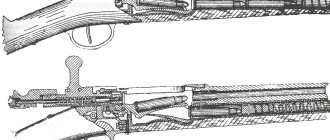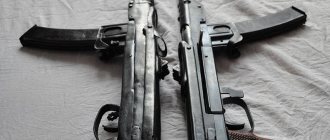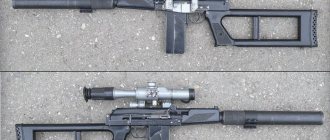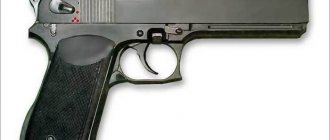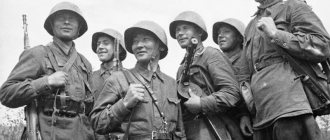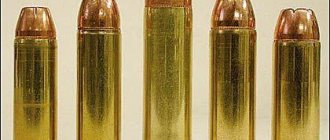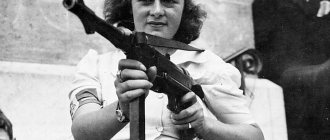Superautomatic from Primus
The emergence of a simple and technologically advanced PPSh allowed the Soviet military to reconsider the concept of using small arms on the battlefield. And the deadly efficiency of platoons and companies of machine gunners to some extent compensated for the shortcomings of the domestic DP-27 machine guns, which were noticeably inferior in firepower to the German MG-34 and MG-42. Of course, any submachine gun was hopelessly inferior to a full-fledged machine gun in terms of effective fire range, but it was convenient to use when storming trenches and buildings.
And yet, the Red Army soldiers demanded something lighter and more compact, “like the Germans.” The answer to these requirements was the PPS-42 designed by Alexey Sudaev. Already in February–March 1942, the Main Artillery Directorate (GAU) conducted the first field tests of prototypes of new domestic SMGs, made taking into account the ergonomic and technical features of the German MP-40 - sector magazine (so-called horn), only automatic fire mode, relatively low rate of fire, plus most samples had folding metal stocks instead of wooden stocks.
The final tests (May–June 1942) included Shpagin's new submachine gun, PPSh-2, and the design of the little-known gunsmith Sudaev. The Shpaginsky submachine gun lost, but thanks to the powerful lobby represented by the People's Commissar of Armaments Dmitry Ustinov, the release of an experimental batch of PPSh-2 for military testing was initiated. Then the leadership of the GAU, which relied on the teaching staff, sent Sudaev to the Sestroretsk tool plant in besieged Leningrad so that the designer would set up production of his machine gun there.
Sudaev’s sample was distinguished by its exceptional simplicity, even in comparison with the very simple PPSh. Almost everything was stamped in it, including parts of the trigger mechanism. The exceptions were the barrel, bolt, and springs. If the production of PPSh required almost 14 kg of metal and 7.3 machine-hours, then the PPS “ate” only 6.2 kg of metal and its production took 2.7 machine-hours (costs were reduced by more than half).
Nevertheless, the Sestroretsk plant, where Degtyarev’s PP were made, was initially unable to master the production of new weapons! At the old arms factory they were used to milling and drilling, but they didn’t really know how to stamp. Then the local Primus artel got involved, making... yes, primus stoves and kitchen tiles. Within two months, specialists in the production of household appliances helped gunsmiths organize the production of stamped components for PPS. The only components that could not be made in the besieged city were the trunks - they were transported from Izhevsk.
Sudaev submachine gun
The PPS automatic system operated on the basis of a free shutter, firing was carried out from the rear sear. The bolt was located in the upper part of the breaking receiver, which was noticeably thinner than that of the PPSh, which had a positive effect on the weight of Sudaev’s weapons. By “stretching out” the receiver and thus increasing the length of the bolt stroke, Sudaev reduced the rate of fire of his PP to 600 rounds per minute.
In general, the new submachine gun was noticeably more ergonomic than its predecessor: the safety was easily turned on and off with the finger of the hand holding the pistol grip; thanks to the lightness and compactness of the butt, the machine gun was quite convenient to throw up; a sector magazine for 35 rounds was easily attached in one movement due to a special neck.
It was possible to hold the weapon by the same neck, since there was no forearm. The PPS magazine had a double-row exit of cartridges, which made it easier to load. In general, a little training is enough for the average shooter to get used to firing the PPS from different positions. In 1943, Sudaev modernized his submachine gun, making it a little more compact and lighter. The modernized model went into production under the designation PPS-43.
Design features
Many parts, as well as their purpose, on the PPS-43 and PPSh-41 are quite similar, which is explained by the installation of maintaining combat performance. The Sudaev PPS assault rifle consists of a receiver. The device includes a barrel, bolt and return mechanism. The design also uses a trigger box, which contains the trigger mechanism and safety lock. These two parts are connected by hinges.
Attached to the rear of the receiver is a stock that can be folded. And in front of the trigger is the magazine neck. The steel box is shaped like the letter "P". It is made from a single sheet of steel. From below it is open along its entire length. Its front part forms the barrel casing, which is intended to protect the shooter from burns. Thus, PPS-43 has greater safety than its predecessor. And a special device practically eliminates the impact on a person of a device such as a PPS machine (photo can be seen below).
Best doesn't mean first
The PPS-42/43 initially had no chance of becoming the main assault rifle of the Soviet army, since the mass production of PPSh was already well established in many industries in the country. Nevertheless, before the end of the war, Soviet industry managed to produce about half a million Sudaev assault rifles, and another 1.5 million were produced in peacetime. As planned, the PPP was received primarily by reconnaissance officers, paratroopers, and crews of combat vehicles. A certain amount still fell to ordinary soldiers, although according to a number of characteristics, the PPS was more of a special weapon rather than a combined arms weapon.
Today, Russian and foreign authors of articles and books about weapons often call the PPS-43 the best assault rifle of World War II. There are no references to the results of comparative tests, but the fate of the machine speaks in favor of the fact that even if it is not the very best, it can definitely take a place among the best. Even during the war, the PPS became a desired weapon for both the USSR's allies and its opponents.
Soon after their appearance at the front, the new submachine guns ended up in the hands of the Finns, and they quickly began producing their own clones of the Soviet machine gun at the Tikkakoski plant. Only, unlike the original, the “Finn” used a German 9x19 mm cartridge. And he didn’t have time to fight - weapons began to reach the troops after Helsinki left the war. Nevertheless, the Finnish PPS under the designation KRM/1944 was in service with the army until the 1960s, until it was replaced by a local clone of the Kalashnikov RK62 assault rifle from the Valmet company. And decommissioned KRM/1944 were successfully exported to numerous “hot spots” around the world.
In a roundabout way, the Finnish teaching staff ended up in West Germany: at the end of 1944, the chief engineer of Tikkakoski, the German Willy Daugs, fled to Spain, taking with him a complete set of technical documentation for the KRM/1944. After the war, Daugs moved to Germany and set up production of a slightly modified PPS under the DUX-53 brand. His machine gun turned out to be more complex than the original and was not accepted as the main weapon of the Bundeswehr, nevertheless, the border guards and gendarmerie of the Federal Republic of Germany were armed with it. In the late 1960s, Daugs went to South America with a Soviet machine gun.
As for the USSR, after the war the PPS was in service with the army until the adoption of the Kalashnikov assault rifle, and then until the end of the 1980s it was used by paramilitary guards. The Soviet Union sold and donated a successful submachine gun to all friendly regimes. So, from the beginning of the 50s, the PPS was produced in Poland: at first the original, and from 1952 a local version with a wooden stock (Modell 43/52). In the mid-50s, serial production of PPS was established in China, which, in turn, armed North Korea, Vietnam, and almost all of Asia with it. Before the mass distribution of the AK, the Sudaev submachine gun remained one of the most numerous and advanced types of automatic weapons in Asia and Africa. The latest information about the use of military personnel in combat operations came from the territory of the DPR and LPR.
Story
Before moving on to the description of the weapon, it is necessary to consider its creation. The history of the PPS assault rifle begins in 1942, when the predecessor PPSh no longer met the new framework. However, the government believed that the new machine should have the same features as the outdated model. Therefore, the requirements put forward by him required the creation of a submachine gun that would be more technologically advanced and simpler in design and operation, but would have the same advantages as the PPSh. Designer Sudaev, after whom the legendary weapon was named, put forward his project, which turned out to be the best.
Photo PPS-43
Incomplete disassembly of PPS-43
Similar
AK-47 assault rifle cartridge caliber 7.62 mm.
Device. Rate of fire AK-74 assault rifle cartridge 5.45 mm caliber. Device. Rate of fire
Dragunov SVD sniper rifle caliber 7.62 mm. Device
AKS-74U assault rifle cartridge caliber 5.45 mm. Device. Weight
Mauser K96 pistol cartridge caliber 7.63 and 9 mm. Device
Pistol Walter PP / PPK cartridge caliber 7.65 and 9 mm. Device
Pistol Yarygin PYa Grach cartridge caliber 9 mm. Device
DShK machine gun cartridge caliber 12.7 mm. Device. Rate of fire
Luger pistol R.08 Parabellum cartridge caliber 9 mm. Device
Pistol PM cartridge caliber 9 mm. Rate of fire. Dimensions. Bullet speed. Sighting range
Self-loading shotgun Saiga-12 cartridge, caliber. Device
Maxim machine gun cartridge caliber 7.62 mm. Device. Weight
PPSh-41 Shpagina submachine gun cartridge caliber 7.62 mm
APS Stechkin pistol cartridge caliber 9 mm. Device
Nagan system revolver cartridge caliber 7.62 mm. Device
Kalashnikov PK machine gun and PKM cartridge caliber 7.62 mm. Device
Simonov carbine SKS-45 cartridge caliber 7.62 mm. Device
Rifles and carbines Mauser 98 caliber 7.92 mm. Device
PPS-42 and PPS-43 Sudaev submachine gun cartridge caliber 7.62 mm
Pistol Walter P38 cartridge caliber 9 mm. Device
MP-40 German submachine gun cartridge caliber 9 mm. Device
VSS Vintorez sniper rifle caliber 9 mm. Device
Submachine gun PP-91 Kedr cartridge 9 mm caliber. Device
Light machine gun RPK-74 cartridge caliber 5.45 mm. Device
Pistol Glock 17 cartridge caliber 9 mm. Device
Makarych, Izh-79-9T, MR-79-9TM, MP-80-13T traumatic pistol
AK-12 assault rifle cartridge caliber 5.45 mm. Device. Weight
Mosin rifles and carbines Three-line caliber 7.62 mm
PMM Makarov pistol modernized 12 rounds. Device
Revolver Colt Single Action Army (SAA) Peacemaker. Device
Machine gun PKP Pecheneg cartridge caliber 7.62 mm. Device
Sniper rifle VSSK Exhaust caliber 12.7 mm. Device
Beretta pistol 92 cartridge caliber 9 mm. Device
TT - Tokarev pistol cartridge caliber 7.62 mm. Device
Submachine gun PP-19 Bison cartridge caliber 9 and 7.62 mm. Device
Sniper rifle SV-98 caliber 7.62 mm. Device
Vladimirov KPV machine gun cartridge caliber 14.5 mm. Device
ASH-12 assault rifle cartridge caliber 12.7 mm. Device. Rate of fire
PSM pistol cartridge caliber 5.45 mm. Device
Pistol Colt M1911A1 cartridge caliber 45. Device
Smith-Wesson revolver Russian cartridge, caliber 10.67 mm. Device
Degtyarev DP-27 light machine gun, 7.62 mm caliber cartridge. Device
Shotgun Mossberg 500 Cartridge. Dimensions. Rate of fire. Sighting range
Thompson submachine gun cartridge caliber 11.43 mm. Device
Pistol USP Heckler und Koch cartridge, caliber. Device
Hunting carbine OSK-88 (SVT-40) caliber 7.62 mm. Device
AS Val silent automatic cartridge caliber 9 mm. Device
Submachine gun PP-19-01 Vityaz cartridge 9 mm caliber. Device
Machine gun Kord cartridge caliber 12.7 mm. Device. Weight. Sighting range
Osa - traumatic pistol cartridge, caliber. Device
AK-9 assault rifle cartridge caliber 9 mm. Device. Rate of fire
Degtyarev RPD light machine gun, 7.62 mm caliber cartridge. Device
Automatic OTs-14 Groza cartridge caliber 9 mm and 7.62 mm. Device
Czech pistol CZ-75 (modifications). Device
Browning pistol 1903 cartridge caliber 9 mm. Device
Sniper rifle OSV-96 caliber 12.7 mm. Device
FN P90 submachine gun cartridge caliber 5.7 mm. Device
Submachine gun OTs-02 Cypress cartridge caliber 9 mm. Device
Sniper rifle ASVK Kord caliber 12.7 mm. Device
Automatic AEK-971 Cartridge. Caliber. Device. Rate of fire
Steyr AUG assault rifle (A1, A2, A3) cartridge caliber 5.56 mm
AK series 100 assault rifles. Modifications. Device. Weight. Dimensions
Uzi submachine gun. Cartridge. Caliber. Rate of fire
Pistol SR1M Gyurza cartridge caliber 9 mm. Device
Pistol GSh-18 cartridge caliber 9 mm. Device
SVDK sniper rifle caliber 9.3 mm. Device
Automatic SR-3M Whirlwind cartridge caliber 9 mm. Device
Machine gun NSV-12.7 Utes cartridge, cal. Device. Weight
Kalashnikov RPK light machine gun cartridge caliber 7.62 mm. Device
Sniper rifle VSK-94 caliber 9 mm. Device
Vostok-1 (Jorge-3M) 9mm caliber traumatic pistol. Device
Degtyarev PPD submachine gun cartridge caliber 7.62 mm
English sniper rifle L96A1 cartridge, caliber
M1 Garand rifle cartridge caliber 7.62 mm. Device
Desert Eagle pistol. Device
Smith-Wesson revolver (modifications). Device
Automatic rifle HK G36 (E, K, C, KE) cartridge caliber 5.56 mm
Pistol P-96 cartridge caliber 9 mm. Device. Rate of fire
Pistol GP35 Browning High Power cartridge, caliber. Device
Assault rifle FN SCAR (L, H) cartridge caliber 5.56 and 7.62 mm
Revolver Lefoshe M1856 cartridge caliber 11 mm. Device
Submachine gun PP-90 cartridge caliber 9 mm. Device
AN-94 Abakan automatic Nikonov cartridge caliber 5.45 mm. Device
Submachine gun PP-2000 cartridge caliber 9 mm. Device
Mauser pistol HSc cartridge caliber 7.65 and 9 mm. Device
M16 automatic rifle cartridge caliber 5.56 mm. Device
Fedorov assault rifle cartridge caliber 6.5 mm. Device. Rate of fire
Pistol Baltiets cartridge caliber 7.62 mm. Device
Strizh pistol cartridge caliber 9 mm. Device. Weight. Sighting range
Browning pistol 1910 cartridge caliber 7.65 and 9 mm
Silent pistol PSS Vul cartridge caliber 7.62 mm. Device
Pistol SIG-Sauer P226 cartridge caliber 9 mm. Device
Pistol OTs-27 Berdysh cartridge caliber 7.62 mm and 9 mm. Device
AK-107 assault rifle cartridge caliber 5.45 mm. Device. Rate of fire
OTs-44 sniper rifle, caliber 12.7 mm. Device
German machine gun MG3 cartridge caliber 7.62 mm. Device
Self-loading shotgun Browning Auto-5 cartridge, caliber. Device
Submachine gun AEK-919K Kashtan cartridge caliber 9 mm. Device
PB pistol silent cartridge 9 mm caliber. Device
Pistol OTs-33 Pernach cartridge caliber 9 mm. Device
Hunting carbine KO-98 cartridge caliber 7.92 mm. Device
TK (Korovin pistol) caliber 6.35 mm. Device. Weight. Dimensions
Underwater assault rifle APS cartridge caliber 5.66 mm. Device
Pistol OTs-21 Malysh cartridge caliber 9 mm. Device
American M60 machine gun, 7.62 mm caliber cartridge. Device
MTs-116M sniper rifle, caliber 7.62 mm. Device
Automatic 9A-91 cartridge caliber 9 mm. Device. Rate of fire
Submachine gun PP-93 cartridge caliber 9 mm. Device
VAG-73 - Gerasimenko pistol. Device. Weight. Dimensions
Cordon-5 is a traumatic pistol. Device. Weight. Dimensions
Goryunov SG-43 heavy machine gun cartridge caliber 7.62 mm. Device
Webley revolver cartridge, caliber. Device. Dimensions. Weight
Machine gun AEK-999 Badger cartridge caliber 7.62 mm. Device
RP-46 machine gun, 7.62 mm caliber cartridge. Device. Rate of fire
Sniper rifle VS-8 cartridge caliber 8.6 mm. Device
Slostin machine gun cartridge caliber 7.62 mm and 14.5 mm. Device
Assault rifle Tavor TAR-21 cartridge caliber 5.56 and 5.45 mm
Submachine gun SR-2 Veresk cartridge caliber 9 mm. Device
Lancaster pistol cartridge caliber 12.1 mm. Device. Rate of fire
Submachine gun PP-90M1 cartridge caliber 9 mm. Device
Underwater pistol SPP-1M. Device. Weight. Dimensions
Traumatic pistol MP-461 Guard. Device. Weight. Dimensions
Lebel rifles and carbines are cartridgeed in 8 mm caliber. Device
Automatic A-91 cartridge caliber 7.62 mm. Device. Rate of fire
M14 automatic rifle cartridge caliber 7.62 mm. Device
Revolver Smith & Wesson Model 10 Military & Police
Automatic rifle FN FAL cartridge caliber 7.62 mm. Device
Submachine gun STEN MK 2. Device. Weight. Dimensions
Traumatic pistol IZH-78-9T Chain mail cartridge caliber 9 mm
Leader-M traumatic pistol 11.43×32T. Device. Weight. Dimensions
Ingram M10 and M11 submachine gun. Device. Weight. Dimensions
Pistol Steyr M9-A1 cartridge caliber 9 mm. Device. Weight
Pistol OTs-23 Dart cartridge caliber 5.45 mm. Device
Berthier rifles and carbines caliber 8 mm. Device
Automatic shotgun USAS-12 cartridge caliber 18.5 mm
Sniper rifle VS-121 caliber 7.62 mm. Device
Traumatic pistol MP-353 cartridge, caliber 11.43 mm
Tiss machine gun cartridge caliber 9 mm. Device. Rate of fire
Traumatic pistol MP-355 cartridge caliber 9 mm. Device
Automatic double-medium ADS cartridge caliber 5.45 mm. Device. Rate of fire
Traumatic pistol MP-81 cartridge caliber 9 mm. Device
Pistols Zastava 70 and 70(k), cartridge caliber 7.65 or 9 mm. Yugoslavia
Sniper rifle GALATZ (Galil) cartridge caliber 7.62 mm
Pistol MP-444 Bagheera cartridge caliber 9 mm. Device
Revolver Colt New Army / Navy. Device. Bullet speed. Sighting range
Type 64 is a Japanese automatic rifle. Device
Comments
0 samcos 03/21/2017 10:38 PPS should not have replaced PPSh! This weapon was originally intended for landing, reconnaissance, and tank crews. Before the advent of the PPS, reconnaissance and landing forces usually used captured MP-38, MP-40 or PPSh with a carob magazine.
Reply | Reply with quote | Quote
0 Kostyr 03/21/2017 10:41 I could shoot a couple of bursts of water out of it
Reply | Reply with quote | Quote
0 Ivanchenko 03/21/2017 10:43 I quote Kostyr:
I wish I could fire a couple of bursts out of it
Now this is impossible.
The Law of the Russian Federation “On Weapons” states that all civilian weapons should not fire in bursts and have a magazine capacity of no more than 10 rounds. From the factory, the automation is cut off to release it into civilian circulation. Otherwise, Article 222 of the Criminal Code of the Russian Federation. Reply | Reply with quote | Quote 0 Rachkovsky 03/21/2017 10:45 In civilian life this is very rare. PPS-43 was released into civilian circulation in very small quantities. And the price for it is steep - 85,000 rubles, which is more than 1,000 euros.
Reply | Reply with quote | Quote
0 Afanas 03/21/2017 11:03 Good cars, and for reconnaissance and in cars in general, the best thing, however, in terms of accuracy, power and rate of fire, the PPSh was superior to it - that’s why no one switched completely to the PPS, but they produced both. Each machine has its own pros and cons... Well, naturally, both were better than any German submachine guns before the advent of the Sturmgiver, but it appeared late, and was also difficult to manufacture.
Reply | Reply with quote | Quote
0 Sergej 03/21/2017 11:06 The other day I held both the PPS and the PPSh and also fell into Thomson, in terms of ergonomics the PPS is the most successful, lightweight, fits perfectly in the hands, Thomson is heavy, how heavy can it be because of this, and more precisely, carry it around I wouldn't want to fight.
Reply | Reply with quote | Quote
+3 Dimon Dimonov 10/06/2017 12:36 Simple as a ruble coin...But at the same time: reliable, lethal, compact, aimed at mass production. A striking example of how, in difficult war conditions, with limited resources and unqualified workers, you can still create a small weapons masterpiece. Sudaev did a great job, he made a weapon out of three pieces of metal that effectively beat the enemy.
Reply | Reply with quote | Quote
0 DeGreen 12/02/2018 21:25 Very many Western DRGs have PPP 43 in their arsenal. They set the Piccatini bar, and that’s it.
Reply | Reply with quote | Quote
0 Dmitry 12/02/2018 21:29 One of the Priblatika countries bought a bunch of PPS 43 and shortened the folding stock, installed a collimator sight and plastic magazines, they are very successfully selling it to all sorts of DRGs
Reply | Reply with quote | Quote
Update list of comments
Escapement mechanism
The PPS (automatic) has an interesting design. The release mechanism, like most of the parts, is extremely simple. It consists simply of a trigger and a lever, which are connected by an axis. A mechanism is integrated with the trigger box latch. They also have a fuse attached to them. The latch locks both boxes in the closed position. The safety device is created in the form of a plate, which is located on the right wall of the trigger box (on its inside).
This position allows you to simultaneously block the trigger mechanism, lock the connecting axis, and lock the bolt. The latter is fixed in the position in which it was when the submachine gun was put on safety. There are two positions here: front and back. In the first, the bolt is secured by the end of the safety plate, which rests against the handle on the reverse side. In the rear position, the bolt handle is secured in the middle part. Thus, a fuse is a device that is controlled by a plate. The machine itself stands on it after moving the handle down and up.
The magazine latch, which is located in front of the trigger guard, is covered with a bracket welded to the neck. It prevents you from accidentally pressing the latch, but at the same time it is intended for convenience. The PPS-43 assault rifle is very functional, its parts often perform several roles, this ensures simplicity of design, and, therefore, speeds up production. It is unlikely that you will be able to create a PPP (automatic machine) with your own hands - this requires special conditions and equipment.
